Student Thoughts
now browsing by category
Morphology of Roy Lichtenstein’s Artwork
- What parts of the image do you see?
1st image: I see a blonde hair woman, tears streaming down a sad woman’s face, a thought bubble, a man in his suit and tie, and a yellow background
2nd image: I see a blonde hair blue eyed woman, tears streaming down a sad woman’s face, a thought bubble, words, and a bed or sofa
3rd image: I see a blonde hair blue eyed woman, a window, a thought bubble, staircase, and words
- How do those parts interact with each other?
1st: Since the man is in the thought bubble, the woman is obviously crying while thinking about him.
2nd: The woman is lying on a bed or sofa crying and thinking about something.
3rd: The woman is sitting beside a window that gazes at the nighttime city thinking about a man.
- Is this image telling a story?
1st: Yes the woman probably thinking about a loved one she’s lost or broke up with
2nd: Yes the woman is crying and thinking about how things should’ve been.
3rd: Yes the woman is wondering about where a man is at, probably a loved one
- Which parts of this image are characters in the story?
1st: The women is character of the story but the man can also be an important character since he’s the cause of the woman’s tears.
2nd: The women is obviously the subject or character of the story
3rd: Just like the previous images, the woman is also the character of the story
- Which parts of this image are crucial for the setting of the story?
1st: Not really a setting except a yellow background but it could probably mean she’s in a brightly lit room.
2nd: There’s not really much of a setting except for the couch/bed the woman is lying on
3rd: The window, night sky and skyscrapers create the background of the picture
- Which parts of this images are crucial for the plot?
1st: The crucial element is the women and the man in the thought bubble because it shows that thinking about the man make her cry.
2nd: The crucial element is the women and the words in the thought bubble because it shows us that she’s crying and regretting something.
3rd: The crucial element is the women and the words in the thought bubble because it shows us that she’s thinking about someone and wondering where he’s at.
- How do these parts interact?
1st: Shows that woman is thinking about a man she loves that has broken her heart
2nd: Shows that a women is lying in bed crying over a relationship probably that should’ve began another way.
3rd: Shows that its late at night woman is probably waiting for her man to come back hoe but he hasn’t come back yet so she’s worried.
- What parts of this image are “root” or “stem” parts and which parts feel like “affixes”? Why?
1st: The root of the image is the woman, the man in the bubble and the tears b/c they are crucial to the plot of the image. The affixes would be the colors, the tiny dots on the characters faces and the bold outlines.
2nd: The woman and her tears are the roots of the image because she’s the main character of the picture and the tears help show the emotion she’s feeling. The words inside her thought bubble is also the stem because it shows us what she’s thinking about that caused her to cry. The affixes would be the bed she’s laying on, the colors and the bold outlines.
3rd: The roots of the image is the woman and the words inside her thought bubble because it shows us that she’s thinking and concerned over someone. The windows, the buildings and the night sky are also the stem because they make up the background and setting of the image. Without it we won’t know that the woman is up late waiting for someone. The affixes would be the staircase, bold outlines, Ben-Day dots and colors because they kind of hold the hold image and brings it together.
- Of the affixes, can you say which are “inflectional” (they only exist to hold the grammar together) and which parts are “derivational” (they add some important information to the meaning, or change the kind of meaning of a given part)?
1st: I think the bold outlines and the Ben-Day dots on the characters faces are derivational. Without them, we’d not be able to see what the image is about because those are what basically make up the picture. The color of the picture however, is inflectional. Without colors, we will still be able to make out the important parts of the image such as the crying woman and the man in the thought bubble. The coloring just adds to the image but doesn’t affect the plot of the image.
2nd: The bold outlines on the picture are derivational because without them, we wouldn’t be able to make out what’s actually in the picture. For example without these black lines we probably won’t be able to tell that’s a woman’s face we’re seeing. Colors again is inflectional it’s just there to tell there to give the audience some extra details such as the woman has blonde hair and blue eyes but those are just minor details not crucial to the plot. The object the woman is laying on also is inflectional, it’s not really part of the background or anything and is just there to give the audience some extra details about the image. Without these inflectional affixes we will still be able to see what the woman is crying about.
3rd: The staircase would be inflectional because it doesn’t really do much to the image doesn’t tell us much about the story of the picture except the woman has a 2 story house. The bold outline, ben-day dots and colors however are what gives meaning to the picture and brings out the plot. The bold outlines and Ben-Day dots are derivational because they’re basically what forms the entire picture, without it we won’t be able to get a clear idea of what the picture is. The colors in this picture unlike the previous pictures are also an important part because the dark blue background outside the window lets us know its nighttime which is crucial for the plot.
10. Find what patterns repeat across the three images you’ve chosen.
All three images revolve around a sad women concerned about romance. In two of them the women are even crying over love. I assume they’re probably the same woman because they all have the same colored hair and in two of the images we can see that both woman have the same colored eyes. They’re probably also troubled for the same reasons by the same man. Another similarity is that the women are always thinking about something, hence the thought bubble. The art style of these images looks like what we’d see in comic books but there are no dialogues at all in these three pictures. The message these images are trying to send out is probably that women think too much and are always troubled by romance because they revolve their lives around men too much. Lastly the artist of these images tend to use the same colors to create these images. He mainly uses colors like yellow, red, blue and white which helps make the images pop out at people even more.
Pictures: Conveying Meaning Through it Parts
The three photos I decided to use all depict a woman. This woman is the root of all the images, for she is the main focal point of the pieces. It is her that is the source of the image in which the viewer emotional connects to the piece.
In the first image, the woman cries as she thinks about a man. At this moment, it is unclear whether they are romantically involved, until you view the other two images. Once viewing the other two pictures, it becomes apparent that the man is her significant other. But the third image creates further confusion, for the woman may no longer love her partner.
In the first image, the thought of the man is an unbound affix. Although he is unbound, he is derivational. This is because, the thought of the man gives significant insight to the emotion the woman is feeling. She is either saddened over him or misses him. The emotion of sadness is conveyed through the way her mouth forms a frown, while in the second image it appears to be a smile conveying a sense of pleasure.
In the second image, the man is an unbound derivational affix as well. This is because, without the man, the viewer would not be able to understand why the woman is crying and an incorrect assumption would most likely be drawn. For the woman is crying due to overwhelming joy, but if the man wasn’t there holding her, she would merely appear sad.
The tears the woman is shedding may be considered an allomorph but I would argue against it, for in the first image they appear to be tears of sorrow. But in the second image I believe the tears are tears of joy. This is because she is reunited with her lover and she is crying because she is so happy that they are together. In either case, the tears are bound affixes for on their own they wouldn’t convey significant meaning, but attached to the woman, the viewer is able to sympathize and understand how the woman feels.
In the last image though, the woman maintains a blank composure. She has a slightly empathetic look on her face, but I feel that is because she is about to break it off with her boyfriend. She says, “I love you, too… But…” This creates a very ominous feeling in the viewer; as if the woman is about to say something she doesn’t want to say but has too. The speech bubble in the third image is an unbound derivational affix, for without it, the piece’s meaning would be unclear to the viewer.
#roylichtenstein #popart #comicart #morphology #visualdissection
Turning Pictures into Morphemes
Throughout all of the images there is the pattern of organic life. The child inside the brain of the man who is smoking the essence of butterflies which to me is an allusion to DMT. The reason I believe it provides that allusion because there are endegenous stores of DMT in our brain for which we have no reason; some have theorized its the flash between your life or that it is associated with sleep. No one really knows and those who do usually have ulterior motives. Perhaps the child is a metaphor for the sense of Self. I also see this picture as a blend of the mechanistic sciences that Newton and to a lesser degree Descartes had a hand in to the more modern approaches in quantum physics which does not disregard Newton’s accomplishments but you could say improved them. Then there are the male and female citizens chasing after a UFO (Unidentified Flying Object). Here we see a male and female most likely outside their teenage years holding hands and trying to communicate with this flying object; they presume it is innocent. Perhaps they both had a positive abduction experience and are wanting to thank them. The third one is a ladybug on a surrealist landmark of a fork and spoon intertwined. This intertwining only happens once and the ladybug is located on the spoon. It is done in a very surrealistic form which seems like an influence from Salvador Dali.
The morphology for the man breaks down into the substance he is smoking; for without the butterfly essence there would be no power for the child inside. It is vital to its nutrition. For the male and female citizens following the UFO the morphology must be the organic whole that we can see. We could assume that this UFO is operated by an extraterrestrial which is what the author may have intended but to stick with the pattern it is organic life. The fork and spoon landmark morphology comes down to the tiny lady bug despite the colossal difference in size it still is the only thing that contains organic life. Another theme I’ve been noticing is it is a very unique to Earth to have organic life though Drake’s equation says we are not the only organic beings in existence but for now I’ll stick with what the world knows.
For the man smoking I would say the man is the root since the child is self-contained within him and that the pipe with its butterfly essence is the affix. For the male and female who are chasing the UFO it is the UFO which is the root because without the UFO what would the male and female be chasing? This makes them the affix. For the fork and spoon landmark it is the fork and spoon intertwined as the root and the ladybug as an affix.
Adopting a derivational mode could completely change the root and affixes for all of the images. For example if we changed the meaning of what is the root opposite of the standard then in the man smoking image it would be the butterfly essence as the root. In an inflective sense it could alter it slightly for examples adding an s to ladybug would make multiple ladybugs there is no way of knowing if it would just be like 2 more or over 9000. Say it is over 9000, we would have to change the root in an almost derivational sense.
I was unable to find any allophones because of how distinct each of my images were.
Images from Omni Magazine on tumblr.
Morphology of Images
What parts of the image do you see?
I see outer space, a naked woman, a star erupting, and a skeletal man smoking.
How do these parts interact with each other?
When I look at these images together I think it could possibly represent new life. In the first image it seems to me that the woman is in pain, which could possibly have to do with child birth. In the second image, I think that the bursting star against the earth represents the beginning of new life on earth. In the third image, a small child sleeps inside a skeletal head, which could refer to the innocence every child is born with before the influence of toxicity which is human life form.
Are these images telling a story?
Yes, I believe that each image tells the story of a beginning of new life. A woman bares a child, that child makes a permanent impact on the earth (represented by the exploding star) and that new life is within all human existence.
Which parts of this image are characters in the story?
I believe that the woman is the main character in the story, because she creates new life on earth. The small child in the last image represents new life and the characteristics which make new life pure.
Which parts of this image are crucial for the setting of the story ?
The parts I see which are crucial for the setting of the story, is the way that the woman is laying. To me, it looks like she is evoking a feeling of pain and bliss. This pain represents the physical pain of new life, and the bliss represents the joy of creation.
Which parts of this images are crucial for the plot?
The idea of the story is about the creation of new life. I think that the exploding star represents the moment new life arrives on earth which is what the entire story of images is based off of.
How do these parts interact?
The theme of new life interacts with the theme of outer space, in that with new life it can be changed in a small moment of life. Along with the small moment of emotion created by new life, the galaxy shows signs of new life as well.
What parts of this image are “root” or “stem” parts and which parts feel like “affixes”?
The parts of this image that feel like “root or “stem” parts, I think that the specific way the woman is laying is a root of the events which will soon occur; I believe that these events will be child birth and the formation of new life.
As far as the “stem” is concerned, to me it seems that the galaxy/milky way apparition that the woman is lying on come hand in hand with the root to form the affix.
In this image the affix is most likely the small stars which make up the galaxy in the middle image. If the image is blown up you can see small stars shooting from the large star, representing the different walks of life all new beings come from.
Of the affixes, can you say which are “inflectional” (they only exist to hold the grammar together) and which parts are “derivational” (they add some important information to the meaning, or change the kind of meaning of a given part)?
In the images I think that the only inflectional images are inside of the middle picture. I placed these images in this order for that specific reason. To me, the bursting star represents the woman’s child birth and the last picture of the small child inside the man’s head. The middle image serves as a means of communication between the woman and her child. For me the derivational images in the picture focus in on the last image. I really love this picture because I think that it makes the connection between new life and innocence, with ending life and toxicity. The fact that a small child is inside the head of a man smoking symbolizes the delicate balance of innocence and knowledge+experience.
By Julia McGonigal
Images from: Omni Magazine Reboot :http://theomnieffect.com/archive

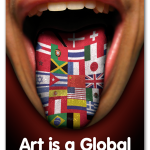


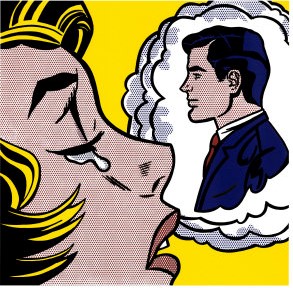

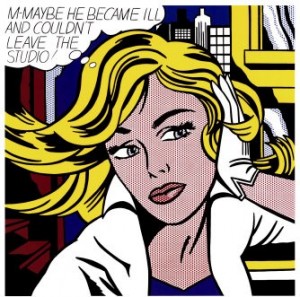

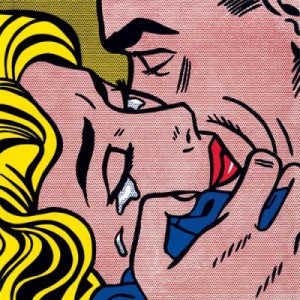
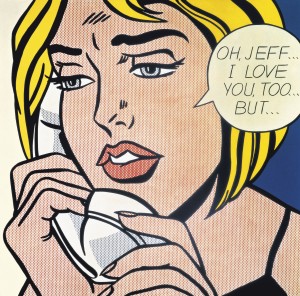
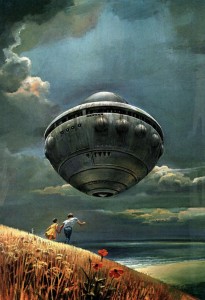

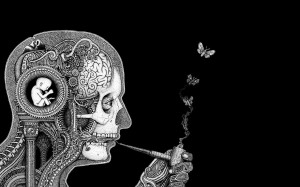
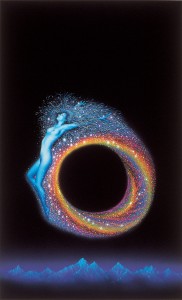

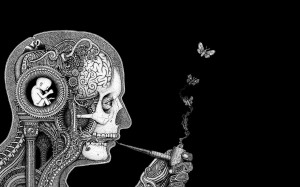
 D5 Creation
D5 Creation